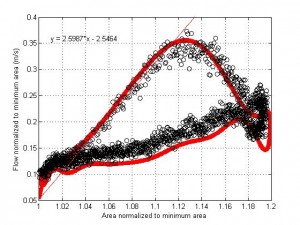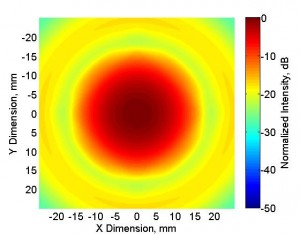Continuous and Non-invasive Blood Pressure Monitoring via an Ultrasonic Method
- Category: Medical Electronics
- Tags: hae-seung lee, joohyun seo
An arterial blood pressure (ABP) waveform provides valuable information in treating cardiovascular diseases of patients in a critical-care unit. In addition, hemodynamics studies such as investigation of vascular impedance have been hindered by lack of reliable non-invasive techniques for monitoring ABP. This waveform is usually obtained through a pressure transducer connected to an arterial catheter. Even though this invasive method is recognized as the gold standard for monitoring ABP, ABP monitoring via an ultrasonic method is preferable because of the potential portability of an ultrasound system and its non-invasive nature, thus minimizing tissue damage as well as the possibility of infection.
ABP monitoring is achieved by observing the pulsatile change of a cross-sectional area as well as identifying elastic and mechanical properties of an arterial vessel, which are represented by a pulse wave velocity (PWV; the propagation speed of a pressure wave along an arterial tree)[1]. The PWV can be estimated by obtaining a flow-area plot for several cardiac cycles and then measuring the slope of the loop during a reflection-free period (e.g., the early systolic stage)[2]. Figure 1 shows the simulated PWV estimation from the flow-area loop during several cardiac cycles. A volumetric flow rate is calculated from an average flow velocity of a uniformly insonated sample plane located at a vessel, and the change of cross-sectional area is estimated by integrating a vessel wall velocity calculated using time-domain cross correlation technique. Figure 2 shows a simulated ultrasonic beam pattern at the sample plane. An electronic data acquisition system incorporates a high-voltage pulser, an analog front end (AFE), and a digital block implemented with FPGA (Field Programmable Gate Array). A received acoustic wave is pre-amplified and digitized through AFE and processed in FPGA to extract necessary information for completing the flow-area plot.
- Figure 1: Flow-area plot of real (red line) and simulated (black dot) data. Both axes are normalized to minimum area. The slope of the normalized flow-area loop is the same as the slope of a non-normalized flow-area loop. During the early systolic stage, a volumetric flow rate is almost linear to a cross-sectional area, and the slope of the loop represents the PWV at local measurement site. The simulated flow-area loop is plotted for several cardiac cycles.
- Figure 2: Simulated beam pattern on the sample plane at the depth of 130 mm. The frequency of transmitted acoustic wave from a single element transducer is 2.25 MHz. The beam pattern shows enough uniformity around the center of the sample plane to illuminate the entire cross-section uniformly.
- B. Beulen, N. Bijnens, G. G. Koutsouridis, P. J. Brands, M. C. M. Rutten, and F. N. van de Vosse, “Toward noninvasive blood pressure assessment in arteries by using ultrasound,” Ultrasound in Medicine and Biology, vol. 37, no. 5, pp. 788-797, 2011. [↩]
- S. I. Rabben, N. Stergiopulos, L. R. Hellevik, O. A. Smiseth, S. Slordahl, S. Urheim, and B. Angelsen, “An ultrasound-based method for determining pulse wave velocity in superficial arteries,” Journal of Biomechanics, vol. 37, pp. 1615-1622, 2004. [↩]

